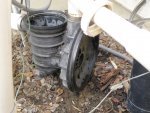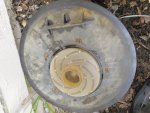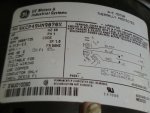- Jun 15, 2011
- 19
Hello,
I have a sta rite wet end (from the 70s?). I believe 1hp impleller (not sure. i have not removed the impeller, I attached a picture and serial # on the shrout is C103-137P1)). The wet end was formerly (before i got the house) attached to a 1hp sf 1.65 a.o.smith (8A@230V). now attached to an a.o. smith 3/4hp sf 1.65 motor (7.3A@230V) model SQ 1072. Plumbing is 1.5inch from/to pool and 2inch from/to spa. Cartridge filter says 138GPM / 136sqft. No water features except 3 spa jets, no solar. The pump uses electricity at about 20cents/kWh. I currently run it for 6 hours a day. Vacuum power is plenty now and I feel a bit less would be fine.
I want to reduce electricity use, so I want more efficiency. I would not mind running the new pump setup almost continuously. I plan to install a SWG in the future and not sure how much minimum GPM these need. I'm contemplating several options.
0) drop the impeller HP to 3/4 or 1/2 $50
1) install a two speed a.o. smith ~$350
2) drop to a 1/2hp or 3/4 hp impeller and install a two speed a.o. smith ~400
3) the above with an efficient a.o. smith ~550
4) get a used whisperflow (about $100 here) and hook it up to a two speed. $450 to $ 650
5) intelliflow or another pump with $200 electical utility company rebate
Basically i'm wondering
- do i save electricity if i keep this motor and down-size the impeller? is there any reason why the result would be less _efficient_ at moving water? (i.e. I assume it would move less GPM, draw some less A and I could run for a little longer)
- if a recent whisperflow wet end would significantly enhance efficiency compared to sta rite from the 70s.
- is changing the impeller is all i need to modify the wet-end's HP (i.e. need to change housing?).
I've been quite impressed by some posts in this section. Some serious engineering is going on here. Still a lot to learn so I will appreciate your suggestions.
thanks
I have a sta rite wet end (from the 70s?). I believe 1hp impleller (not sure. i have not removed the impeller, I attached a picture and serial # on the shrout is C103-137P1)). The wet end was formerly (before i got the house) attached to a 1hp sf 1.65 a.o.smith (8A@230V). now attached to an a.o. smith 3/4hp sf 1.65 motor (7.3A@230V) model SQ 1072. Plumbing is 1.5inch from/to pool and 2inch from/to spa. Cartridge filter says 138GPM / 136sqft. No water features except 3 spa jets, no solar. The pump uses electricity at about 20cents/kWh. I currently run it for 6 hours a day. Vacuum power is plenty now and I feel a bit less would be fine.
I want to reduce electricity use, so I want more efficiency. I would not mind running the new pump setup almost continuously. I plan to install a SWG in the future and not sure how much minimum GPM these need. I'm contemplating several options.
0) drop the impeller HP to 3/4 or 1/2 $50
1) install a two speed a.o. smith ~$350
2) drop to a 1/2hp or 3/4 hp impeller and install a two speed a.o. smith ~400
3) the above with an efficient a.o. smith ~550
4) get a used whisperflow (about $100 here) and hook it up to a two speed. $450 to $ 650
5) intelliflow or another pump with $200 electical utility company rebate
Basically i'm wondering
- do i save electricity if i keep this motor and down-size the impeller? is there any reason why the result would be less _efficient_ at moving water? (i.e. I assume it would move less GPM, draw some less A and I could run for a little longer)
- if a recent whisperflow wet end would significantly enhance efficiency compared to sta rite from the 70s.
- is changing the impeller is all i need to modify the wet-end's HP (i.e. need to change housing?).
I've been quite impressed by some posts in this section. Some serious engineering is going on here. Still a lot to learn so I will appreciate your suggestions.
thanks





